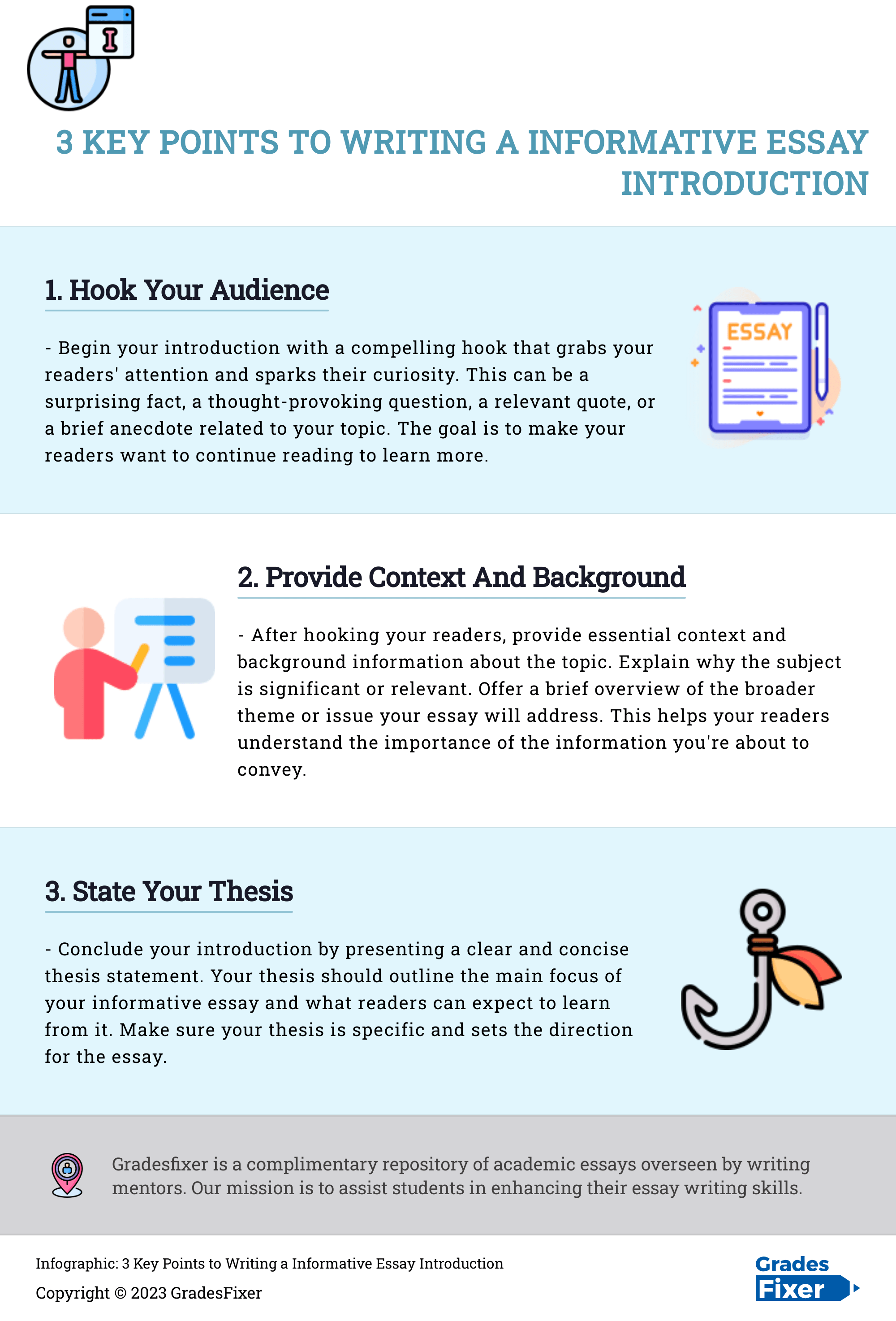Informative Essay Examples
Selecting an informative essay topic is a critical step in the writing process, shaping the direction and scope of your essay. The topic you choose should not only capture your interest but also offer ample opportunities for research and exploration. In this guide, we'll explore strategies for choosing the right ...
Selecting an informative essay topic is a critical step in the writing process, shaping the direction and scope of your essay. The topic you choose should not only capture your interest but also offer ample opportunities for research and exploration. In this guide, we'll explore strategies for choosing the right topic and provide a diverse range of examples across various categories to inspire your writing journey.
When selecting an informative essay topic, consider your interests, expertise, and the preferences of your audience. Begin by brainstorming ideas based on subjects that intrigue you or align with your academic field. Conduct preliminary research to gauge the availability of credible sources and the depth of information on each topic. Additionally, assess the relevance and significance of potential topics, ensuring they align with the objectives of your essay and offer value to your readers.
Examples of Good Informative Essay Topics
Health and Wellness
- The Benefits of Meditation for Mental Health
- Understanding the Importance of Vaccinations
- Exploring Alternative Medicine Practices
- The Impact of Artificial Intelligence on Society
- Emerging Technologies in Renewable Energy
- The Future of Space Exploration
Science and Technology
- Innovations in Online Learning Platforms
- Strategies for Effective Study Habits
- The Evolution of Literacy in the Digital Age
Education and Learning
- The Legacy of Ancient Civilizations: Egypt, Greece, Rome
- Women's Rights Movements Throughout History
- Cultural Traditions and Festivals Around the World
History and Culture
- Addressing Climate Change: Causes and Solutions
- The Importance of Biodiversity Conservation
- Sustainable Practices for Reducing Plastic Pollution
Environment and Sustainability
- The Effects of Social Media on Mental Health
- Analyzing Global Refugee Crises and Solutions
- Racial Inequality in Criminal Justice Systems
Social Issues and Politics
- Understanding Cryptocurrency: Benefits and Risks
- The Impact of Globalization on Local Economies
- Financial Literacy: Budgeting and Saving Strategies
Economics and Finance
- Exploring the Evolution of Film Genres
- The Influence of Music on Mood and Emotions
- Cultural Significance of Literature and Folklore
Arts and Entertainment
- Sustainable Tourism Practices: Balancing Conservation and Recreation
- Hidden Gems: Off-the-Beaten-Path Destinations
- Cultural Immersion Through Food and Cuisine
Travel and Tourism
- The Psychology of Sports: Mental Toughness and Resilience
- Exploring Extreme Sports and Adventure Activities
- Sportsmanship and Ethics in Competitive Athletics
Sports and Recreation
🌟Read More: Informative Speech Topics about Sports🌟
Some Informative Essay Ideas for Inspiration
- The Influence of Social Media on Teenagers
- Benefits of Renewable Energy Sources
- Importance of Financial Literacy Education
- Causes and Effects of Climate Change
- Types and Treatments of Anxiety Disorders
- Evolution of Artificial Intelligence
- Diversity and Inclusion in the Workplace
- Effects of Sleep Deprivation on Health
- Cultural Customs and Traditions Around the World
- Education's Role in Economic Development
By considering these examples and employing effective strategies for topic selection, you can embark on your informative essay writing journey with confidence and enthusiasm. Remember to choose a topic that aligns with your interests, offers valuable insights to your audience, and inspires further exploration and learning.
Mastering the art of informative essay writing is invaluable for students across all academic disciplines. Whether you’re tasked with dissecting complex topics or elucidating fundamental concepts, honing your skills in this form of composition can significantly enhance your academic prowess. In this guide, we’ll delve into key strategies and techniques to help you craft compelling and informative essays that captivate your readers’ attention and convey your message effectively.
Understanding the Informative Essay
Before embarking on your writing journey, it’s crucial to grasp the essence of informative essays. Unlike persuasive or argumentative essays, which aim to sway the reader’s opinion, informative essays primarily seek to educate and inform. These essays present factual information in a clear, concise, and engaging manner, devoid of personal bias or subjective viewpoints. By adhering to this objective stance, you can maintain credibility and authority in your writing.
Selecting a Compelling Topic
The foundation of a successful informative essay lies in the choice of an intriguing and relevant topic. Whether you’re exploring historical events, scientific phenomena, or societal issues, opt for subjects that pique your interest and offer ample scope for exploration. Conduct thorough research to ensure the availability of credible sources and sufficient information to support your discussion.
📕 Discover: Free Compare and Contrast Essays
Additionally, consider your target audience and their level of familiarity with the topic to tailor your essay effectively.
Structuring Your Informative Essay
A well-organized structure is essential for conveying information effectively in your essay. Begin with an introduction that provides context and previews the main points you’ll cover. Follow this with a series of body paragraphs, each focusing on a distinct aspect or subtopic related to your chosen subject. Use topic sentences to introduce each paragraph’s main idea and support it with evidence, examples, and relevant data. Finally, conclude your essay by summarizing key points and reinforcing the significance of your topic.
To craft an effective introduction for an informative essay, focus on engaging your readers while providing essential context.
Here’s an example of an informative essay introduction following these guidelines:
“Have you ever wondered how social media platforms collect and use your personal data? In an age where online privacy concerns continue to grow, understanding the intricacies of data collection is crucial. In this informative essay, we will delve into the world of data mining by social media giants, exploring how your information is gathered and utilized to personalize your online experience. As we uncover the methods and implications of this practice, you’ll gain valuable insights into the digital landscape and learn how to protect your online privacy effectively.”
This introduction combines a captivating hook, context about the topic’s significance, and a clear thesis statement to engage the reader and set the stage for the informative essay.
Before you continue with our free example of informative essay, make sure that you check our informative writing checklist, which will help you structure and keep your writing readable and logical:
✔️ Your tone should be informative as the purpose of this essay type is to inform. (Explain your subject by starting with a brief introduction or the fact that will inspire your readers.)
✔️ You have studies the topic and gathered some evidence to support the facts. (It can be statistica data, peer-reviewed journals, or quotes from the books in print. Use only verified resources.)
✔️ Focus on your audience and explain complex terms if necessary.
✔️ No argumentation or bias is allowed.
✔️ Only the paragraph before.
✔️ The conclusion can contain analysis that speaks of your opinion.
As always, keep things structured and show due respect and care when informing your readers about sensitive or controversial issues.
How to Start an Informative Essay
What is an informative essay?
The key is to provide your audience with information on a certain topic. You must educate by offering a brief description and accessible information. Some informative essay examples include topics that deal with a process, an effect of something that took place, or the list of ideas that are not common knowledge. Remember that you only provide certain data with no opinion or bias towards any side.
How to write an informative essay?
The trick is to make things readable and clear enough if you are not writing for a specific audience. As a rule, you should provide a brief description and talk about the importance of a certain subject. Use facts, statistical data, and reliable references. It must be informative and implement real-life examples to make your essay supported. Once again, do not use a biased tone and avoid posing an opinion.
The types of informative essays
The examples of informative essays will vary depending on a task that you have been given. The types will divide on the definition of a term, comparison or contrasting of particular information, analysis of discovered data, and an explanation of how something must be done. When using argumentation, try to find information that does not lean towards critical thinking. If it is not possible provide both opinions without stating yours.

- Instructions Followed To The Letter
- Deadlines Met At Every Stage
- Unique And Plagiarism Free



